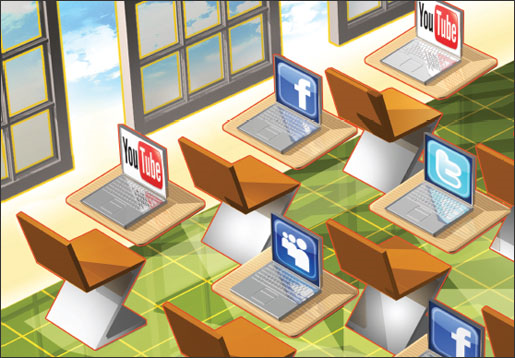
This article has been rewritten to provide a more updated view. Click here to read the updated article, "Regarding Social Media in the Classroom".
Social media is one of the fastest growing forms of communication between family and friends. People converse via wall messages, tweets, and gaming interaction. Social Media plays a huge role in modern-day culture, with millions of people participating; therefore it can be a productive tool in your classroom.
According to Convince & Convert, a digital marketing advisory group, 68% of Americans between the ages of 25-34 are on social media and 22% of them check their account several times per day. This opens a door for teachers to maintain continuous communication with students’ parents.
As with many great tools, social media comes with its advantages and disadvantages. You must be aware of these potential pitfalls and know how to use these tools to achieve success rather than problems in your class. Read our 5 laws to maintain a professional social media account to create open and efficient lines of communication.
It has to be opt-in.
Even though it seems like everybody these days has a Facebook or Twitter account, it's actually not true. Some people may also have these accounts but want to keep them limited to only friends and family for fun purposes. Social media can easily fall into the category of unwanted electronic communication called "spam," so it's essential that parents and students opt-in, confirming that they want to receive communication in this manner. Sending unwanted electronic communications to families will almost certainly result in being reported to your internet service provider - even fined. It's just not worth the risk.
actually not true. Some people may also have these accounts but want to keep them limited to only friends and family for fun purposes. Social media can easily fall into the category of unwanted electronic communication called "spam," so it's essential that parents and students opt-in, confirming that they want to receive communication in this manner. Sending unwanted electronic communications to families will almost certainly result in being reported to your internet service provider - even fined. It's just not worth the risk.
You have to monitor social media accounts.
Unfortunately, social media is a tricky form of communication; you need to make sure that you or another school staff member is monitoring the account. Because social media is more instant communication, many people expect to get an immediate answer to a question sent to your Facebook inbox or tweeted at you. Parents and students will be incredibly frustrated if they expect an immediate answer and you don't follow up for a week.
As a security issue, it's also important to monitor your social media account for bullying activity. The nature of online networks lends itself to allowing people to bully others, and unfortunately, this type of behavior is not limited to children and teens. Social media in the classroom must be very closely supervised to make sure this behavior doesn't take root.
Protect your passwords
A misguided Facebook message or Tweet has caused  many public relations disasters. Don't let that happen to you! Protect your social media security by limiting the number of people who have access to your social media accounts. Use extra caution if you're sharing a more open-ended account with multiple teachers or staff members at your school because that increases the likelihood of someone sending out an inappropriate message that could land you in hot water, too.
many public relations disasters. Don't let that happen to you! Protect your social media security by limiting the number of people who have access to your social media accounts. Use extra caution if you're sharing a more open-ended account with multiple teachers or staff members at your school because that increases the likelihood of someone sending out an inappropriate message that could land you in hot water, too.
Know when to use discretion
Social media is great for communicating lighthearted or informational messages. Need to let your students' parents know that parent-teacher conferences will be rescheduled because of inclement weather? That's an example of one great reason to use social media. But when it comes to talking to a parent about a serious discipline issue that affected their student, social media is too impersonal. Communicating that kind of information by social media is a sensitive situation that could affect your job security. Social media protection means that you follow the guidelines set out by your school district.
Teach students how to be safe
It's a tragic fact of life that kids are at risk of being victims of potential predators. One venue for child predators to reach kids is through social media. Today's version of "stranger danger" is more likely to present  itself in the form of a Facebook message from a user who looks like another child than a creep in a white van. Your number one rule should always be Safety First! Therefore it's imperative to teach your students about the essentials of social media safety: don't ever give out their address or phone number to anyone over social media, even if the stranger seems trustworthy.
itself in the form of a Facebook message from a user who looks like another child than a creep in a white van. Your number one rule should always be Safety First! Therefore it's imperative to teach your students about the essentials of social media safety: don't ever give out their address or phone number to anyone over social media, even if the stranger seems trustworthy.
Now that you have an understanding of some of the social media pitfalls to be aware of, go forth and Instagram, Tweet, and Facebook your little heart out! Use social media to recognize the good things that are going on in your classroom and achieve efficient communication with your classroom parents. Allow students to see how a responsible person should use these modern-day tools rather than abusing them for narcissistic self-involved agendas. Happy Teaching!

.png?width=220&name=Do%20You%20Pocatello%20Podcast_%20(1).png)
